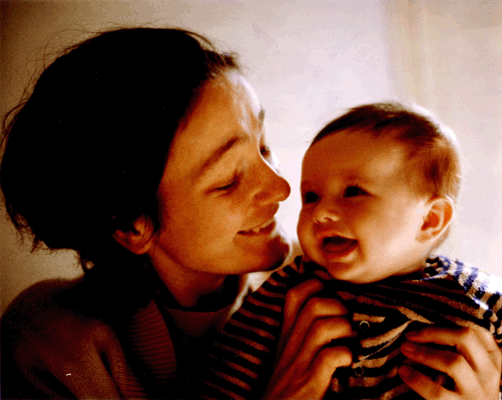
Morag Harris1954-2000
|
||
|---|---|---|
| 'Morag was known to her Italian and British friends as a person of intensities... She belonged to the rebellious post-war generation, and had clearly "beaten out her exile". She would never settle for the status quo. Morag's poems take off from the writers she loved, and go for the essential.' Massimo Bacigalupo |
|
Morag Harris' book is groundbreaking in its rich and nuanced account of Emily Dickinson's prose' 'Harris' study suggests how to read Dickinson, not merely what we are reading, in the sense of a message or 'position'. It is itself notably pleasurable to read.' |
Morag Harris was born in London on 17 November 1954. She attended Camden High School for Girls, where she acquired a keen interest in literature and the classics, and after being uncertain which to choose to study, she opted to read English, very much in the family tradition. At LMH, Oxford, she also took up her music in earnest and from that time played the piano regularly, as later her daughters did also. After graduating she worked for a time in publishing, first in London and then in Bologna, Italy, where she married and raised her three children. In 1981 she became a lecturer at the University of Bologna, where she continued to teach until her early death in December 2000. Her book Emily Dickinson in Time, a model for dating Dickinson’s poems by internal linguistic means, was published in 1999 by Karnac Books. Morag wrote poetry throughout her life and a selection of her poems is in preparation (click here). Morag’s interests, as both poet and scholar, lie in the linguistic transformations that take place when the received signs of conventional poetic language metamorphose into the idiosyncratic symbols of a new poem. She was also concerned with the tensions between poetic identity and personal fruition. Two years before she died she had commenced a doctoral thesis evaluating the influence of the Romantics on Emily Dickinson’s poetic practice. In contrast to the general critical view, Morag did not see Emily Dickinson as a `rootless flower’; rather, she saw her poetic identity as forged by her struggles with the language of other poets and her search for the `chiefest words’. Dickinson was shaped by her understanding of the Romantics’ struggle with their own great forbears Shakespeare and Milton (that `great florist’). Morag did not have time to complete this investigation, but the essays included in Linguistic Transformations demonstrate her vital awareness of the poet’s need to immerse him or herself in poetic tradition, through presences both overshadowing and nurturing, restrictive and stimulating, and then to emerge from it differentiated and individuated, a distinct species. For a sample essay, 'Emily Dickinson's loaded gun', click here. Morag inherited her mother’s spirit of fun and her perspicacity about human nature, and her father’s black curly hair and poetic talent. She was a wild and tomboyish child, whose rebellious streak caused amusement and anxiety in equal measure. From childhood she made passionate attachments and her friends were always very important to her. The same applied to her love of horses. Rather than dolls she kept a large suitcase in which she gradually collected tack etc for the horse that she dreamed of one day owning. Being a city girl she had to start by mucking out stables on Hampstead Heath in exchange for riding lessons, and her riding ambitions were complicated by the fact that the family spent most summer weekends on their sailing boat on the east coast. But eventually her dream was realised, and she kept her own pony on her uncle’s farm in Sussex, taking the Greenline bus at weekends to go and ride with her cousins. Morag hated solitude; she was most herself in the company of friends, spicing serious discussions with satirical portraits which left everyone in gales of laughter. Her mother attributed Morag’s fluency in speaking foreign languages to the fact that Morag simply could not bear being unable to communicate with people, so if they couldn’t speak her language, she learned theirs – and quickly. She became a lecturer at Bologna university, with the idea of its being a temporary post, since she always had a certain restlessness. But as it turned out she continued in it with a few gaps, becoming a much respected teacher, for the remainder of her life. With her marriage there, and three children, the family became Anglo-Italian, and many happy holidays were spent in the chestnut-covered mountains of Tuscany, despite everyone being devastated by the death of Mattie in 1986 following a road accident. After her own illness was diagnosed, she made strenuous efforts to live her remaining life to the full, starting work on a Ph.D., writing and travelling to conferences around the world. She died on 11 December 2000 aged just 46. Her book on Emily Dickinson testifies to her intense admiration for poetry as a craft as well as for its emotional aspects. Her vivacious and humorous spirit continues to inspire in memory those who knew her well. |
||
PublicationsEmily Dickinson in Time: Experience and its Analysis in Progressive Verbal Form (Karnac, 1999) click here Linguistic Transformations in Romantic Aesthetics: collected papers, edited by Morton Paley and Meg Harris Williams (Mellen Press, 2002) click here Selected Poems click here
|
||
